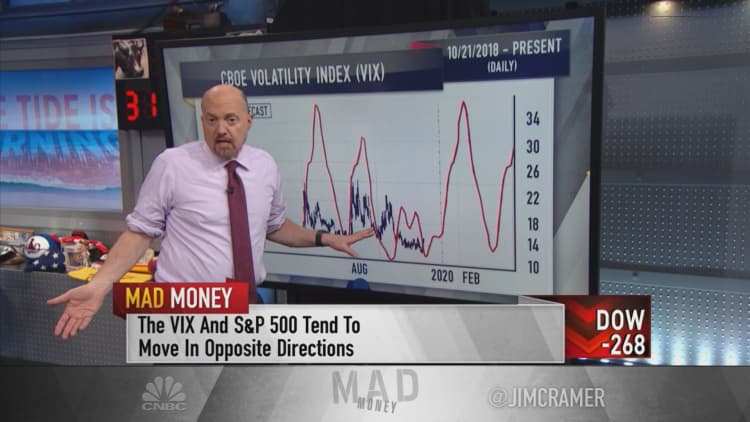
After enjoying weeks of record highs, investors should brace for impact in case the stock market turns ugly.
Wall Street could face some pressure in coming months as stocks revert to more attractive levels, CNBC's Jim Cramer said Monday.
"The charts as interpreted by Larry Williams suggest that the market's animal spirits are turning from bullish to bearish, at least for the next few months, and he thinks you should try to sidestep the pain here," the "Mad Money" host said.
The S&P 500 has rallied nearly 10% from early August. Technical analysis from stock trader Larry Williams, who created various market indicators including the Williams %R, suggests it may be peaking as investor sentiment takes a turn.
The CBOE Volatility Index, known as the VIX, surged about 14% to 14.44 on Monday as the S&P fell nearly 0.90%. The VIX is widely known as the fear gauge — it goes down when investors are bullish and goes up when they are bearish — and Williams used the presumably cyclical measure to call the bottom in August, Cramer said.
In late August the host broke down Williams' thesis that investors starting in September should expect the market to rally big. The S&P 500 went on to set a series of closing highs through November.
The VIX neared 25 points in early August and fell under 12 — its lowest point of 2019 — in late November.
"Right now, based on the volatility cycle, he's anticipating a sustained upturn in the VIX, which tends to be very bad for the S&P 500. Based on his forecast, the volatility index should keep rising through Feb. 11," Cramer said. "In other words, investors are starting to turn bearish here, and Williams expects them to stay that way for the next couple of months."
Williams, Cramer said, also projected that the S&P 500 could undergo tough trading during much of the first quarter of 2020. He used the Dollar Index, which compares the strength of the U.S. currency to foreign money, as a stock price indicator to forecast a downward trend in equities, Cramer added.
A weaker greenback works in favor of American exporters but translates into domestic weakness in stocks, the host said. The dollar index has fallen lately, which could be another factor in stock trajectory.
"Based on his cycle forecast, you'd expect the S&P to peak right about now," Cramer said. "The strongest short-term cycle here has lasted for about 80 days, and it suggests the market will be under pressure through the beginning of March."
"We could have one more bounce before the negativity fully takes over, but he thinks you should use any strength to ring the register," said Cramer. "I agree with him that we were due for a shakeout ... and since I expect the president to raise his tariffs on China in two weeks, it might take a little while for the pain to unfold."

Questions for Cramer?
Call Cramer: 1-800-743-CNBC
Want to take a deep dive into Cramer's world? Hit him up!
Mad Money Twitter - Jim Cramer Twitter - Facebook - Instagram
Questions, comments, suggestions for the "Mad Money" website? madcap@cnbc.com



